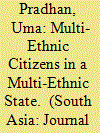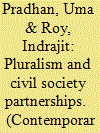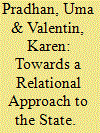|
|
|
Sort Order |
|
|
|
Items / Page
|
|
|
|
|
|
|
| Srl | Item |
| 1 |
ID:
168824


|
|
|
|
|
| Summary/Abstract |
In 1990, the Constitution of Nepal declared Nepal a multi-ethnic (bahujatiya) country. This newly transformed state promised better inclusion of marginalised groups through special provisions. How has this been operationalised, and what does this mean in practice for the members of the groups concerned? Drawing on fieldwork in the Nepal Foundation for Development of Indigenous Nationalities (NFDIN), this paper argues that the Nepali state’s moral and political obligation to address long-standing concerns about group-based inequalities has opened up intriguing new spaces to perform and redefine state–society relations. Within these new spaces, categories of difference are constantly invoked and experienced, where both the state and citizens come to co-constitute each other in a variety of new ways.
|
|
|
|
|
|
|
|
|
|
|
|
|
|
|
|
| 2 |
ID:
075243


|
|
|
|
|
| Publication |
2006.
|
| Summary/Abstract |
Hitherto, South Asian governments have found it convenient to arbitrate between different sections and communities. Increasingly, however, as a multiplicity of demands surface articulating the democratic aspirations of marginalised castes, creeds, tribal peoples and other ethnic groups, governments must work in collaboration with actors in civil society. As monolithically constructed communities are splintered along ‘local’ constituents and development agencies relate rights-based programming with disaggregated data on caste, class and gender, the possibilities for multiculturalism become manifold. Democratic pluralism is key to development. This paper is based on fieldwork in two contiguous regions of South Asia; the Himalayan kingdom of Nepal, and the northern Indian state of Uttar Pradesh. On the one hand, this region has been the hotbed of linguo-religious identity construction and contestation since at least the 1870s, and especially after the 1920s. On the other hand, it has recently been witness to the emergence of strong political movements among hitherto ‘untouchable’ Dalits and landless classes, and the active interest of development agencies. Three broad themes are explored through this paper; the impact of development and markets on Dalit communities, cultures of subjugation and protest among them, and the impact of community-based groups on how they are able to negotiate and contest their disadvantages. The emergence of community-based organisations, especially those formed during the course of the struggle for labour rights, are seen as contributing to democratic pluralism. At the same time, the paper advises caution by emphasising that the formation of community-based organisations is no substitute for political advocacy or technical solutions; rather, they must be grounded in local traditions of protest to be effective.
|
|
|
|
|
|
|
|
|
|
|
|
|
|
|
|
| 3 |
ID:
168820


|
|
|
|
|
|
|
|